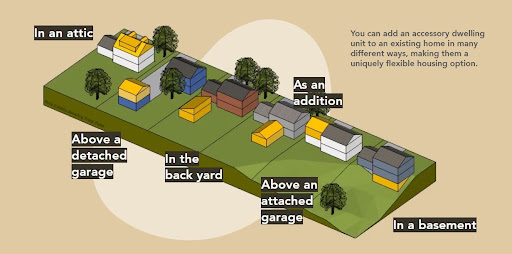New Iowa law will require Iowa cities, counties to allow ADUs


Owners of single-family homes in Iowa will soon be able to add an accessory dwelling unit on their lot, an option that could help address the housing shortage in the state and generate additional income for homeowners.
Senate File 592, which Gov. Kim Reynolds signed into law in early May, requires cities and counties to allow at least one accessory dwelling unit, or ADU, on a single-family lot. The legislation, which goes into effect July 1, sets minimum standards for the units and prohibits overly restrictive local rules.
Adding accessory dwelling units on single-family lots is one way to help address Iowa’s housing shortage, backers of the legislation have said. According to the Iowa Finance Authority, over 21,000 additional homes are needed in Iowa by 2030. ADUs are also a way for property owners to generate extra income and for older people to live independently near a relative, advocates say.
AARP, a nonpartisan advocacy group for older adults, has been a long-time advocate of ADUs. In recent years, AARP Iowa has promoted the housing option at the local level. A year ago, it began advocating for a statewide law allowing accessory dwelling units.
“People want to age in place but sometimes they don’t have a place to do it,” said Paige Yontz, a state advocacy manager for AARP Iowa. “But it’s not just a solution for [the elderly]. It’s also one for caregivers. … I have had many caregivers say ‘I can’t drive across town to take care of my mom but if she lived in something attached to my house.’”
ADUs are “a unique solution,” Yontz said. “It’s not just adding an addition to your house … it’s creating separate living quarters with a bedroom, kitchen and bathroom, spaces that aren’t shared with the main house.”
What are ADUs?
Accessory dwelling units, also known as granny flats or secondary units, are small homes on a single-family lot that are independent of the primary larger home. ADUs can be free-standing or attached to a primary residence; they can be above a garage or in a home’s basement or attic.
Some of the earliest ADUs in the U.S. were carriage houses, built for horse-drawn carriages but also used as living quarters for household workers and others. ADUs were common in the early 1900s but their popularity declined after World War II as populations shifted to the suburbs and zoning ordinances became more restrictive.
Growing demand for affordable housing has prompted cities and states to look at ADUs as a way to increase the supply of homes without noticeably changing the aesthetics of a neighborhood, according to a 2023 report by the Washington, D.C.-based Cato Institute.
Iowa is the 14th state to pass a law allowing the development of accessory dwelling units on single-family lots, according to AARP.
In recent years, several Des Moines-area communities have established policies that allow accessory dwelling units. Among them is the city of Des Moines, which in 2022 expanded where ADUs are allowed to be built.
“We have people ask about them all the time,” Jason Van Essen, planning and urban design administrator for the city of Des Moines, said. “Actually, getting them built has been very limited.”
Eight ADUs have been built in the city since changes were made to city regulations, Van Essen said. Seven were stand-alone units; the other was an addition to a house.
Van Essen speculated that the cost of building an accessory dwelling unit has kept some people from adding them to their property. The Polk County Housing Trust, a nonprofit group that distributes housing funds to Central Iowa groups, estimates that it can cost between $50,000 and $150,000 to build an accessory dwelling unit.
Des Moines has required property owners to live in either the main residence on the property or the ADU. The new state law prohibits the restriction.
“I’ve heard speculation that if Des Moines didn’t have the ownership requirement, we’d see more of them being built – that an investor could get involved and use the property as a rental cash generator,” Van Essen said. “With the new state law, maybe we will.”
Next steps
In the weeks before the law takes effect, AARP Iowa plans to put together a coalition that will work to provide cities and counties with information on accessory dwelling units, Yontz said. “It will take time for people to understand what an ADU is and what the minimal standards are for them.”
One of the other things the coalition will do is share information with financial institutions about lending models used in other parts of the country, Michael Wagler, state director for AARP Iowa, said.
ADUs are “unique housing models and we want [financial groups] to understand what this would look like from the lending standpoint,” he said.
Wagler and Yontz both said that they don’t expect to see a lot of ADUs immediately being built in Iowa.
“We know this won’t help solve Iowa’s housing challenges,” Wagler said. “But, it is another tool in the tool box to help with the housing shortage.”
States with ADU laws
The following are states with laws that allow accessory dwelling units on single-family lots, according to AARP.
1. Hawaii
2. New Hampshire
3. California
4. Oregon
5. Vermont
6. Utah
7. Connecticut
8. Montana
9. Washington
10. Maine
11. Rhode Island
12. Colorado
13. Arizona
14. Iowa

Kathy A. Bolten
Kathy A. Bolten is a senior staff writer at Business Record. She covers real estate and development, workforce development, education, banking and finance, and housing.










